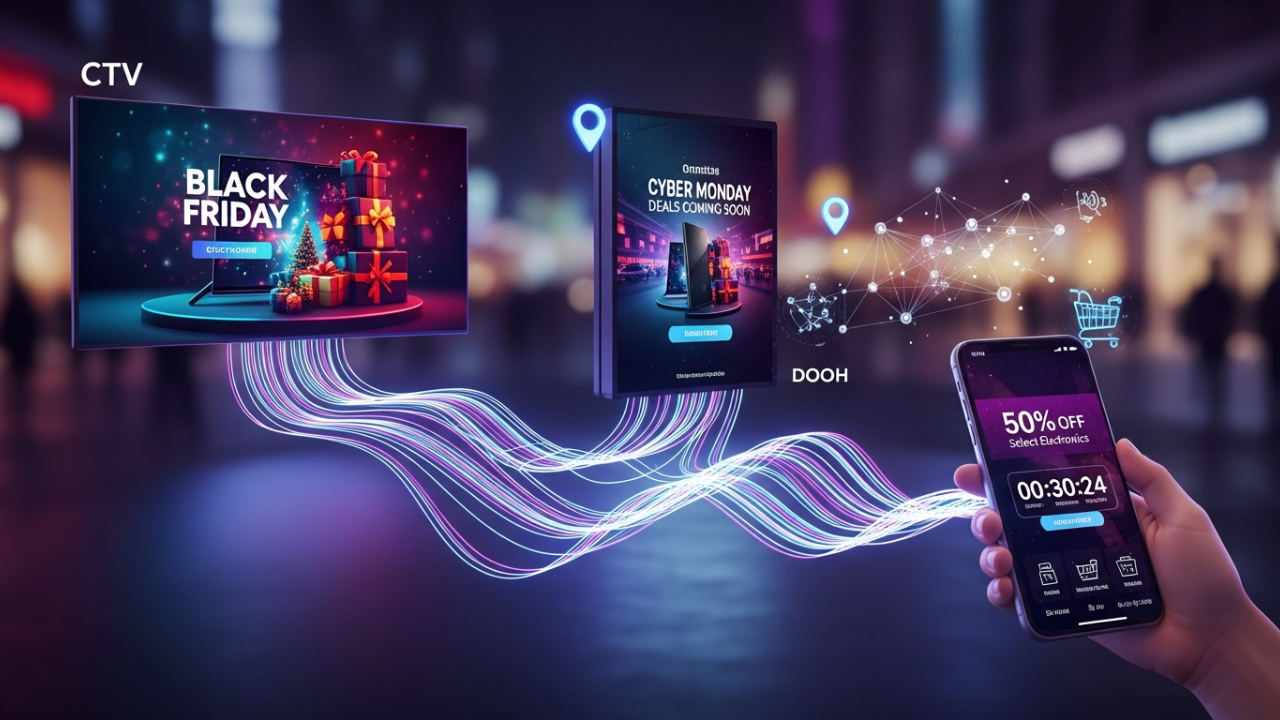Blog
Announcements, analysis and opinions on industry trends around the mobile programmatic world.

Subscribe now, and receive the latest programmatic content directly on your inbox!
Thank you for subscribing to our newsletter
Luxury reimagined: India’s premium segment, its paradoxes, and a smarter way forward

Market overview: A moment of opportunity
India’s luxury sector is entering a landmark phase. As of 2025, India's luxury goods market is valued at USD 18.28 billion (₹1.52 lakh crore). The broader luxury ecosystem — including experiences, real estate, wellness, and hospitality — is expected to surpass USD 85 billion by 2030, a five-fold expansion. India is poised to become one of Asia-Pacific's top five luxury markets, with 1.5 million USD millionaires expected by 2027 (Source). While non‑metro hubs contribute a significant portion of sales (Business Standard), marquee segments are thriving—Swiss watch exports to India are up 20% in 2024 (Financial Times), and supercars like Lamborghini and Maybach are seeing sales growth of 10–145% (Reuters). This surge is largely driven by millennials and Gen Z, while the population of millionaires in India is projected to grow substantially over the next few years (Hurun India Wealth Report), highlighting a deepening demand for premium experiences across the country.
Who are India’s luxury shoppers and what are they buying?
India’s luxury shoppers are no longer confined to a niche elite; they’re an expanding community of affluent professionals, entrepreneurs, and globally exposed millennials who see luxury as a reflection of success, individuality, and taste. Their buying behaviour is defined by aspiration, access, and awareness—shaped as much by heritage and craftsmanship as by digital discovery and social validation.
The Luxury Watches & Jewellery segment dominates the market, accounting for 64% of total revenue—a reflection of India’s cultural affinity for precious metals and the symbolism of jewellery as both investment and identity. Luxury Fashion (15%), Leather Goods (10%), and Prestige Cosmetics & Fragrances (8%) follow, showing how the idea of luxury is steadily broadening from occasion-led to everyday indulgence. (Source: Statista,Sep’24)
When it comes to purchase drivers, India’s luxury consumers are still deeply influenced by their inner circles and perceived value.
- Friends & Family remain the most powerful influence, guiding 49% of buying decisions.
- Deals & Discounts, though traditionally less associated with luxury, sway 42%, signaling a growing comfort with accessible luxury and smart value.
- On the media front, Online Magazines (29%), Celebrity Endorsements (28%), and Influencers (24%) shape aspiration and discovery—fuelled further by brands’ omnichannel presence, which seamlessly connects store experiences with digital storytelling.
In essence, India’s luxury shopper is socially influenced, digitally aware, and increasingly omnichannel—seeking experiences that balance exclusivity with accessibility, and prestige with personal relevance.
It’s about behavior. Movement. Media consumption. Signals.
What it really takes to reach the new luxury consumer.
Affluence today is no longer defined by income alone. The old playbook of postcode targeting and broad demographics doesn’t hold anymore. Luxury in India is no longer limited to a small, predictable elite; it’s distributed, dynamic, and deeply digital.
At mediasmart, we’ve been working to answer a complex question: how do you engage the luxury buyer without wasting a single impression? The answer isn’t more reach. It’s more about precision.
A richer signal for a more refined audience
We began by rethinking how affluence should be defined, building a behavioral, signal-led framework. Affluent audiences today leave distinct digital and spatial footprints. They stream long-form content on large-screen TVs, own high-end smartphones (priced over INR 45,000), frequent premium malls, luxury housing districts, and international terminals. They engage with finance apps, global fashion platforms, and curated OTT content. Each of these actions is a signal. When stitched together, they reveal not just affluence but intent.
Using this model, we identified the luxury consumers across India. More importantly, we identified when and where they’re most receptive.
Where storytelling meets attention
In the world of luxury, every first impression is a statement. It can’t be lost in the noise of a scroll or dismissed as a pre-roll. It must command attention — and Connected TV (CTV) is where that statement now begins. Approximately 70% of CTV users belong to mid-to-high-income segments (Source).
CTV is uniquely positioned to engage high-value audiences. Its large, high-resolution screens create a premium viewing environment, while access to sophisticated audience data allows brands to target based on income, lifestyle, location, and behavior. This ensures that luxury brands aren’t just reaching viewers — they’re reaching the right viewers, at the right moment, in a setting that amplifies brand prestige.
For example, when Burberry targeted ultra-premium audiences in the UAE, CTV delivered 4.2 million impressions with a 93.4% video completion rate. Ads were matched to the content being viewed, and creatives were tailored by geography, store proximity, and behavioral signals — ensuring relevance, not repetition. Attention, when well placed, stays.
Beyond storytelling, CTV can create immersive experiences and drive engagement. With mediasmart’s Creative Sync and QR-led activations, viewers can interact directly from their screens, scan a QR code, and take immediate action. CTV becomes more than a screen — it becomes a launchpad for action, seamlessly connecting inspiration to measurable outcomes.
Beyond the screen, into the journey
But storytelling alone is not enough. Brands need continuity. So we built it.
With our proprietary Household Sync technology we connect the dots across screens. A viewer who explores a premium SUV on CTV doesn’t vanish into a data void; instead, they encounter a follow-up on their mobile device — a booking link guiding them to the website or a nearby showroom. This creates a seamless narrative that goes beyond recall, nudging viewers toward action.
For the Jeep Meridian campaign, this approach delivered over 6 million impressions, a 93.6% Video Through Rate (VTR), and a 1.28% Click-Through Rate (CTR) — proving that integrated storytelling across screens drives real, measurable engagement.
Turning real-world moments into multi-screen impact
Luxury doesn’t just happen online — premium experiences deserve omnichannel presence. We map campaigns to real-world moments. We activate stories in airports, high-end malls, and luxury districts. Not just through Digital Out-of-Home (DOOH) screens, but through Audience sync. A digital screen at a lounge paired with a mobile message later in the day.
MG’s EV campaign used this cross-screen, real-world model to engage premium buyers where they lived— at premium residency. Then those audiences were retargeted on their CTV and mobile devices. The result was a 98.8% video completion and a performance-led CTR of 0.98%.
It’s not the media. It’s orchestration.
Every luxury brand talks about being curated. The same expectation now applies to how they show up in the media. Luxury buyers don’t want noise; they want relevance.
When every impression feels tailored, timely, and deliberate—the message stops being a simple ad. It becomes part of the brand experience.We are not just selling across screens. We are connecting with clients across screens — with precision, purpose, and intelligence.
Because in luxury, less is more. And the correct message at the right moment, in the right place, is worth everything.
Final takeaway: The future of luxury is not just visible, it’s lived through touchpoints and meaningful interaction
Today’s luxury consumer expects more than a polished ad; they expect a presence that aligns with their lifestyle. They want to feel like the brand gets them, not just sells to them.
That means evolving your strategy for a more connected world:
- Prioritize relevance over reach.
- Infuse your media mix with real-world signals.
- Turn every screen into a stage for sequential, meaningful storytelling.
- Measure not just visibility but real impact across the journey.
Because in a market where luxury is exploding, the brands that win will be the ones that understand something simple, yet powerful:
Luxury doesn’t need to shout. It just needs to arrive exactly where it belongs.
Redefine how your brand connects with luxury audiences.
Create precision-led campaigns that elevate storytelling across CTV, mobile, and DOOH.
Write to us at sales@mediasmart.io to craft experiences that resonate with affluence and intent.
Topics: omnichannel campaign, India, Insights, Luxury Segment



.jpg?width=1200&height=627&name=Luxury%20(1).jpg)

.jpg?width=1280&height=720&name=xJQIH69_Ybc-HD%20(2).jpg)
